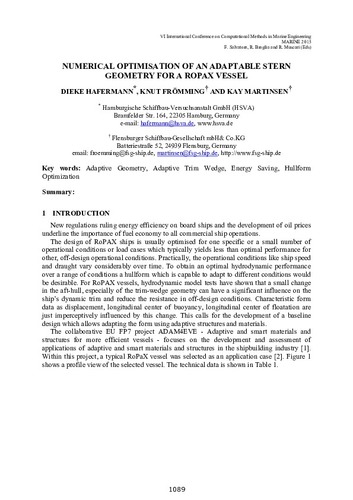Numerical optimisation of an adaptable stern geometry for a RoPAX vessel

Estadístiques de LA Referencia / Recolecta
Inclou dades d'ús des de 2022
Cita com:
hdl:2117/332591
Tipus de documentText en actes de congrés
Data publicació2015
EditorCIMNE
Condicions d'accésAccés obert
Tots els drets reservats. Aquesta obra està protegida pels drets de propietat intel·lectual i
industrial corresponents. Sense perjudici de les exempcions legals existents, queda prohibida la seva
reproducció, distribució, comunicació pública o transformació sense l'autorització del titular dels drets
Abstract
New regulations ruling energy efficiency on board ships and the development of oil prices underline the importance of fuel economy to all commercial ship operations. The design of RoPAX ships is usually optimised for one specific or a small number of operational conditions or load cases which typically yields less than optimal performance for other, off-design operational conditions. Practically, the operational conditions like ship speed and draught vary considerably over time. To obtain an optimal hydrodynamic performance over a range of conditions a hullform which is capable to adapt to different conditions would be desirable. For RoPAX vessels, hydrodynamic model tests have shown that a small change in the aft-hull, especially of the trim-wedge geometry can have a significant influence on the ship’s dynamic trim and reduce the resistance in off-design conditions. Characteristic form data as displacement, longitudinal center of buoyancy, longitudinal center of floatation are just imperceptively influenced by this change. This calls for the development of a baseline design which allows adapting the form using adaptive structures and materials. The collaborative EU FP7 project ADAM4EVE - Adaptive and smart
CitacióHaffermann, D.; Frömming, K.; Martinsen, K. Numerical optimisation of an adaptable stern geometry for a RoPAX vessel. A: MARINE VI. "MARINE VI : proceedings of the VI International Conference on Computational Methods in Marine Engineering". CIMNE, 2015, p. 1089-1094. ISBN 978-84-943928-6-3.
ISBN978-84-943928-6-3
| Fitxers | Descripció | Mida | Format | Visualitza |
|---|---|---|---|---|
| Marine-2015-89_ ... SATION OF AN ADAPTABLE.pdf | 970,0Kb | Visualitza/Obre |

